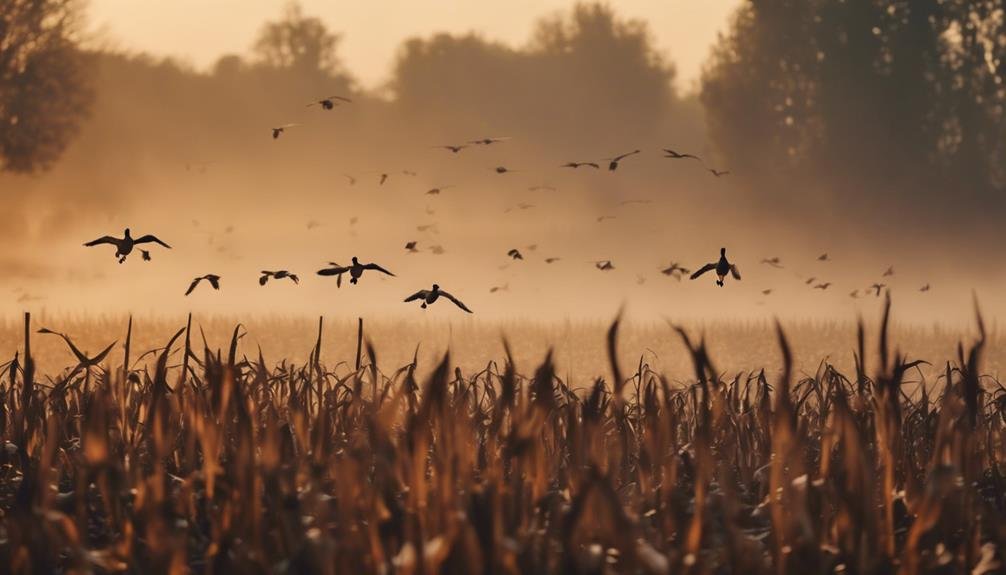Thousands of ducks are deviating from their traditional migration patterns, flocking to flooded cornfields where they find abundant food and shelter. However, this phenomenon has significant implications for duck populations, with many staying in these areas rather than migrating to traditional wintering grounds. Habitat destruction and fragmentation, driven by human activities, disrupt the integrity of waterfowl habitats, leading to population declines and altered migration patterns. As researchers unravel the complexities of duck migration, the intricate relationships between human-altered environments, climate change, and conservation efforts come into focus, revealing a multifaceted issue that demands further exploration and understanding.
Key Takeaways
- Flooded cornfields alter duck migration patterns, as thousands are drawn to these areas, disrupting traditional wintering grounds.
- Corn farming practices create flooded areas, trapping rainwater in standing corn, allowing ducks to feed easily and stay longer.
- Habitat destruction and fragmentation, driven by human activities, disrupt the integrity of waterfowl habitats, leading to population declines and altered migration patterns.
- The concentration of ducks in flooded cornfields raises ethical concerns about unfair hunting practices and unequal access to private lands.
- Climate change impacts, such as altered precipitation patterns and rising temperatures, further disrupt the delicate balance of waterfowl migration patterns.
Flooded Cornfields Alter Migration
Thousands of ducks are being drawn to flooded cornfields, a practice that is increasingly altering their migration patterns, with many waterfowl opting to remain in these areas rather than continuing their journey south. This phenomenon is attributed to corn farming practices, where low-lying areas are flooded, trapping rainwater in the standing corn, allowing ducks to feed easily. As a result, ducks are adapting to this food source, altering their traditional migration routes. This shift in behavior has significant implications for duck populations, with many staying in these areas rather than migrating to their traditional wintering grounds. The impact of flooded cornfields on duck behavior is a pressing concern, warranting further research and consideration in conservation efforts.
Unfair Hunting Practices Debated
The debate over unfair hunting practices has intensified, with many hunters and conservationists questioning the ethics of hunting over flooded cornfields, which are perceived as an unfair advantage. The practice, allowed by federal regulations, raises ethics debates about hunter responsibility. Critics argue that flooded cornfields create an unnatural concentration of ducks, making hunting too easy and unfair. This perceived unfairness sparks concerns about the future of duck hunting, as some hunters feel that the practice undermines the sport's integrity. As the debate continues, hunters and conservationists must re-examine their roles and responsibilities in maintaining a sustainable and ethical hunting tradition.
Climate Change Impacts Migration
Rising global temperatures and altered precipitation patterns are disrupting the delicate balance of waterfowl migration patterns, as ducks respond to changing environmental cues that influence their behavior and habitat use. Climate change impacts are altering the timing and duration of migration, with warmer winters allowing ducks to stay north longer, and changes in precipitation patterns affecting the availability of food and water resources. This disruption can lead to mismatches between duck migration and food availability, ultimately affecting population dynamics. Climate-driven changes in wildlife corridors, such as altered wetland habitats and shifting vegetation patterns, further exacerbate the issue. Understanding the complex interplay between climate change and duck migration patterns is vital for developing effective conservation strategies.
Habitat Destruction and Fragmentation
Habitat destruction and fragmentation, driven by human activities such as coastal development, agricultural expansion, and resource extraction, disrupt the integrity of waterfowl habitats, leading to population declines and altered migration patterns. The loss of wetlands and natural habitats forces ducks to adapt to human-altered environments, altering their migration routes and patterns. This can lead to population declines and changes in behavior.
Here are 4 key ways to address habitat destruction and fragmentation:
- Wetland preservation: Protecting existing wetlands from human activities that lead to degradation and destruction.
- Habitat restoration: Restoring degraded or damaged habitats to their natural state, allowing waterfowl to thrive.
- Conservation efforts: Implementing policies and practices that prioritize waterfowl habitat conservation and restoration.
- Sustainable land-use planning: Encouraging responsible land-use practices that minimize habitat destruction and fragmentation.
The Future of Duck Hunting
What does the future hold for duck hunting, as the debate over flooded cornfields and manipulated waterfowl habitats continues to simmer? As the controversy unfolds, concerns arise about the impact on duck hunting ethics and the demographics of hunters. The debate has sparked questions about the fairness and hypocrisy of current regulations, with some arguing that flooded cornfields alter migration patterns and keep ducks from flying south. As the discussion continues, it is essential to weigh the implications of these practices on hunter demographics and the future of duck hunting. Will the increasing acreage of flooded corn lead to a shift in hunting practices, or will regulations adapt to address the concerns of hunters and conservationists alike?
Private Lands and Access Issues
As private lands with flooded cornfields become increasingly prevalent, concerns arise about the unequal distribution of access to these areas, potentially exacerbating existing disparities among hunters. This issue is particularly significant in Louisiana, where private ownership and land leasing are common practices.
Access Issues:
- Limited access: Many private lands with flooded cornfields are closed to public hunting, restricting access to these areas for many hunters.
- Leasing disparities: Land leasing agreements often favor those with financial means, perpetuating inequalities among hunters.
- Exclusive hunting clubs: Private hunting clubs and outfitters often dominate access to prime hunting grounds, excluding others from these areas.
- Lack of public land: Insufficient public land dedicated to hunting and conservation exacerbates the issue, further limiting access to these areas.
These access issues can lead to resentment among hunters and undermine the sport's integrity.
Manipulated Waterfowl Habitats
Flooded cornfields and other manipulated waterfowl habitats have become increasingly prevalent, sparking controversy among hunters, conservationists, and wildlife managers about their impact on duck migration patterns and the future of waterfowl hunting. These habitats, often created through human manipulation, can alter the natural migration patterns of ducks, leading to concerns about the long-term sustainability of waterfowl populations. Habitat fragmentation, resulting from the creation of these manipulated habitats, can disrupt the natural flow of migration patterns, further exacerbating the issue. Wetland restoration efforts can help mitigate the effects of habitat fragmentation, but more research is needed to understand the full impact of manipulated habitats on duck migration patterns.
Conservation and Habitat Needs
Conservation efforts focused on restoring and protecting habitats that meet the specific needs of various waterfowl species are critical for maintaining the long-term sustainability of duck populations and supporting healthy migration patterns.
Key conservation strategies include:
- Waterfowl refuges: protected areas providing essential habitat for ducks and geese.
- Wetland restoration: rehabilitating degraded or lost wetlands to support waterfowl populations.
- Habitat fragmentation mitigation: reconnecting isolated habitats to promote species movement and genetic exchange.
- Climate-resilient conservation planning: integrating climate change projections into conservation strategies to guarantee adaptability.
Understanding Molt Migration Patterns
Waterfowl biologists have long recognized the molt migration pattern as a vital process in the life cycle of ducks and geese, where they shed and replace their flight feathers, making them temporarily flightless and vulnerable to predators and environmental stressors. During this process, waterfowl undergo a unique feather cycle, where old feathers are replaced by new ones, ensuring ideal wing patterns for flight. This molt migration pattern is essential for the survival of waterfowl, as it allows them to regain their flight capabilities, enabling them to escape predators and migrate to suitable habitats. Understanding the molt migration pattern is essential for effective waterfowl management and conservation, as it provides valuable insights into the behavioral and habitat needs of different species. By studying the molt migration pattern, researchers can develop targeted conservation strategies to protect waterfowl populations.
Effective Waterfowl Management
Implementing effective waterfowl management strategies requires a thorough understanding of the complex interplay between habitat quality, species-specific behaviors, and environmental factors influencing population dynamics. This multifaceted approach involves considering the intricate relationships between waterfowl species, their habitats, and the environmental factors that shape their behavior.
To achieve effective waterfowl management, consider the following key strategies:
- Habitat restoration: Restoring degraded habitats to provide suitable breeding, nesting, and foraging grounds for waterfowl.
- Waterfowl guides: Utilizing knowledgeable guides who understand species-specific behaviors and habitat needs to inform management decisions.
- Species-specific management: Developing management plans tailored to the unique needs of each waterfowl species.
- Monitoring and adaptation: Continuously monitoring population dynamics and adapting management strategies as needed to maintain the long-term sustainability of waterfowl populations.
The Role of Research and Monitoring
Accurate population assessments and habitat evaluations, facilitated by rigorous research and monitoring, form the cornerstone of effective waterfowl management, enabling informed decision-making and adaptive strategies to conserve these species. In the context of duck migration patterns, research plays a vital role in understanding the impact of flooded cornfields on habitat use and behavior.
| Research Component | Description |
|---|---|
| Study Design | Experimental and observational studies to assess habitat use and behavior |
| Data Analysis | Statistical analysis of population trends and habitat use patterns |
| Monitoring Tools | Citizen science initiatives and remote sensing technologies for data collection |
Effective research and monitoring enable data-driven decision-making, informing management strategies that conserve waterfowl populations while addressing the complexities of human-wildlife conflicts. By integrating research funding, research collaboration, and data sharing, we can develop evidence-based solutions to the duck migration mystery.
Frequently Asked Questions
Can Flooded Cornfields Affect Duck Breeding and Nesting Habits?
Flooded cornfields can alter duck breeding and nesting habits by disrupting wetland habitats, as cornfield ecology can lead to modified water levels, vegetation structure, and resource availability, influencing duck behavior and habitat selection.
How Do Changing Weather Patterns Impact Duck Migration Timelines?
Research suggests that changing weather patterns, characterized by weather extremes and temperature swings, can substantially impact duck migration timelines, as altered temperature and precipitation regimes influence food availability, breeding habits, and stopover sites.
Are There Alternative Methods to Flooded Cornfields for Duck Hunting?
Alternative methods to flooded cornfields for duck hunting include dry land management, crop rotation, and wet meadows, as well as food plots with diverse vegetation, offering ducks a natural foraging experience.
Do Private Landowners Have an Unfair Advantage in Duck Hunting?
Private landowners' control over flooded cornfields creates access inequality, granting them an unfair advantage in duck hunting, as they can manipulate habitats and attract ducks, exacerbating disparities in land ownership and hunting opportunities.
Can Habitat Restoration Efforts Offset the Effects of Climate Change?
Habitat restoration efforts, such as wetland revival initiatives, can enhance ecosystem resilience, mitigating climate change impacts on duck migration patterns, but holistic conservation strategies are necessary to fully offset these effects.
Conclusion
In summary, the duck migration mystery persists, shrouded in a complex web of human activities, environmental factors, and biological intricacies. As the debate rages on, it becomes increasingly evident that the future of duck hunting hangs precariously in the balance. Flooded cornfields, climate change, habitat destruction, and fragmented migration patterns all contribute to the decline of duck migrations, begging the question: will the pursuit of sustenance and sport ultimately spell doom for these majestic creatures, or will concerted conservation efforts salvage the future of duck hunting?









